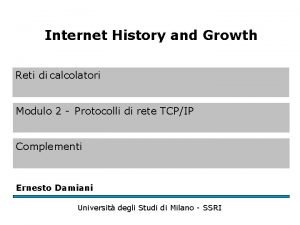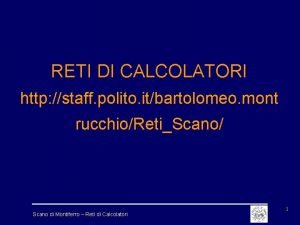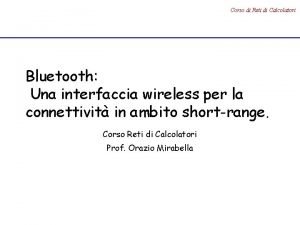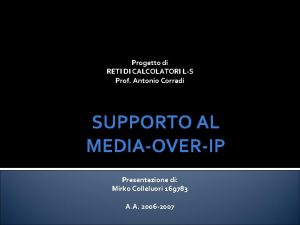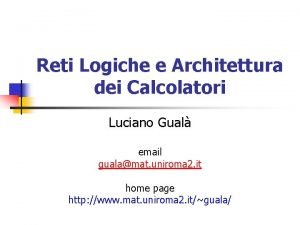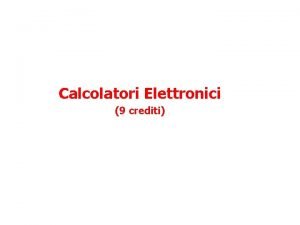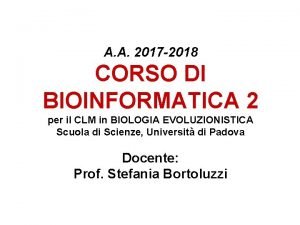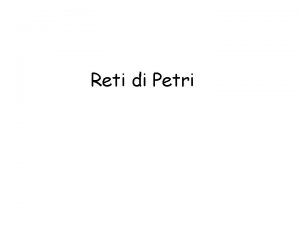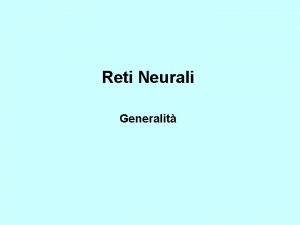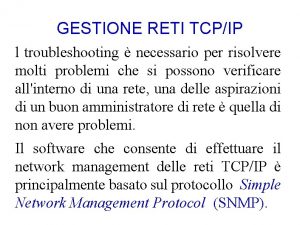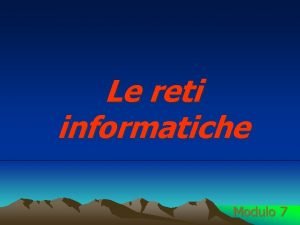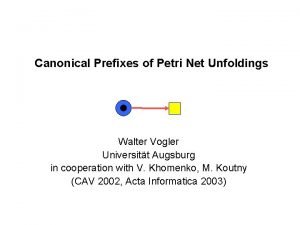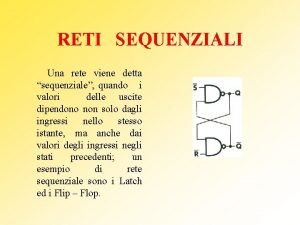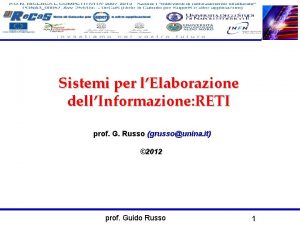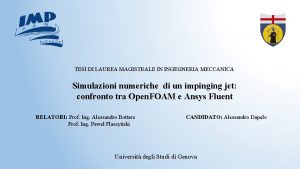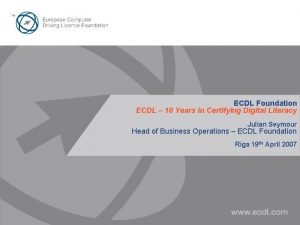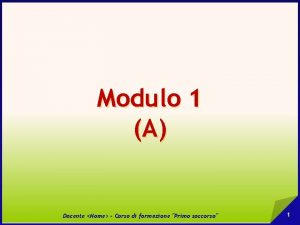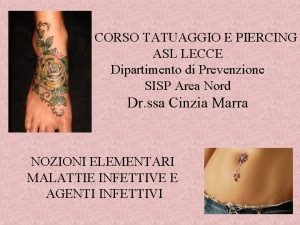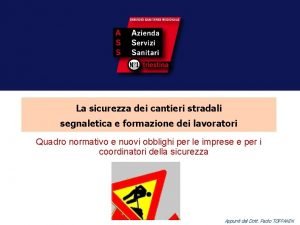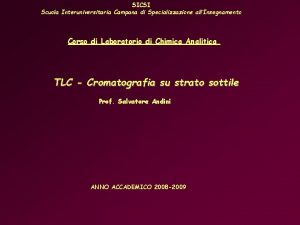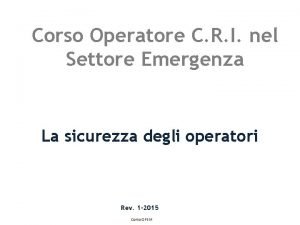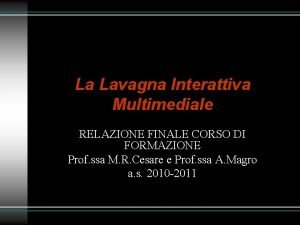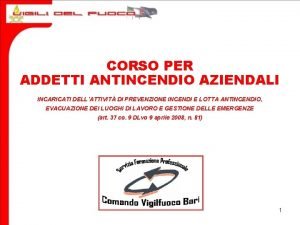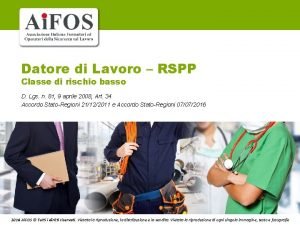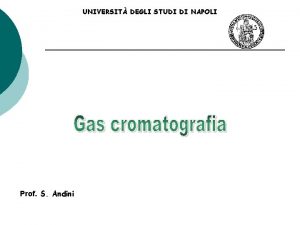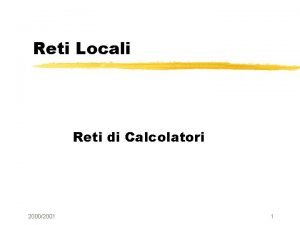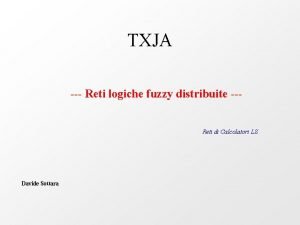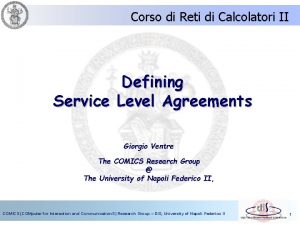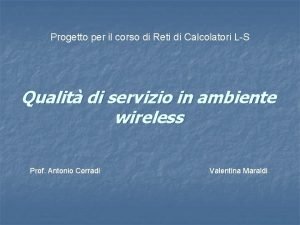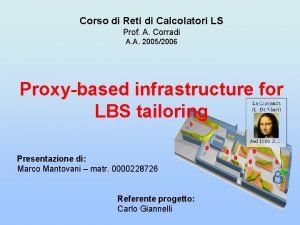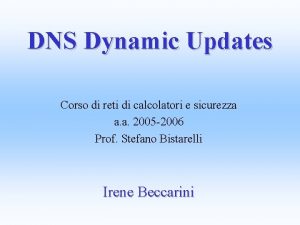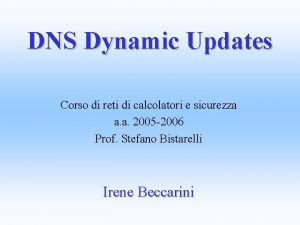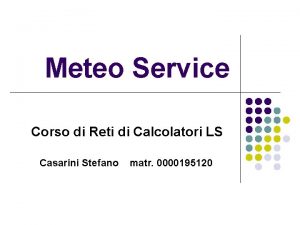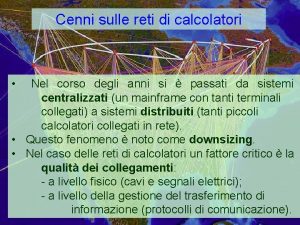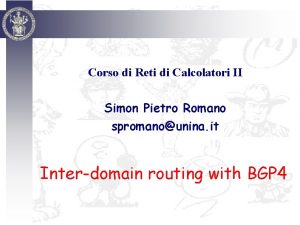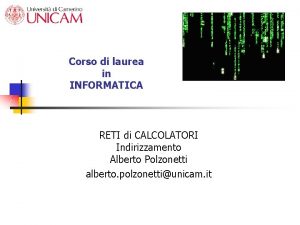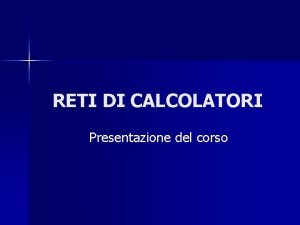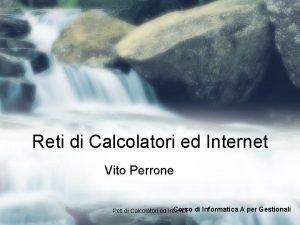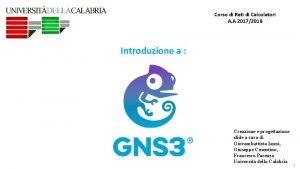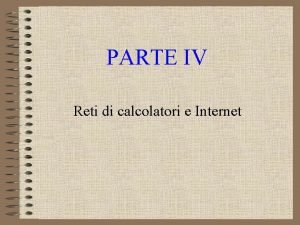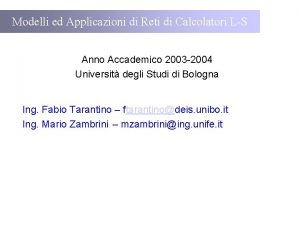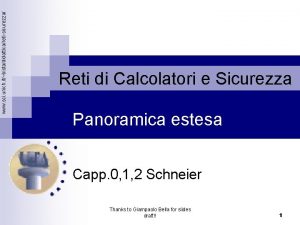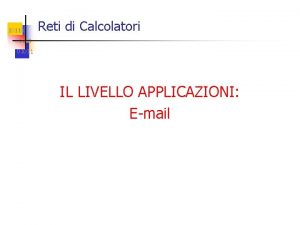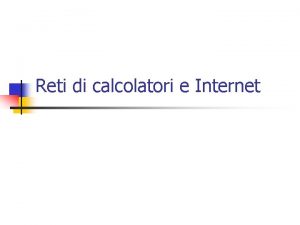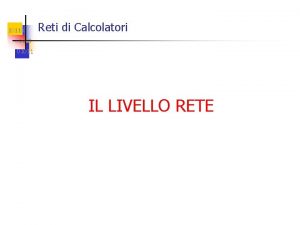Corso di Reti di Calcolatori II A case
































- Slides: 32

Corso di Reti di Calcolatori II A case study: IPTV SLA Monitoring Giorgio Ventre The COMICS Research Group @ The University of Napoli Federico II, COMICS (COMputer for Interaction and Communication. S) Research Group – DIS, University of Napoli Federico II 1

Outline Ø The general problem: SLA, who cares? Ø A business case for Qo. S Ø Defining Service Level Agreements Ø A Real-Life SLA monitoring service Ø A case study: IPTV SLA Monitoring COMICS (COMputer for Interaction and Communication. S) Research Group – DIS, University of Napoli Federico II 2

Recent trends in the industry Ø New emerging multimedia services both in fixed and wireless networks Ø Traditional voice carriers are moving to NGN: ü Essential to control costs and drive up revenues ü Triple play services: Voice – Video – Data ü Video represents a key element of the service portfolio • Price/quality balance must attract/retain users • TV quality must compete with satellite and cable COMICS (COMputer for Interaction and Communication. S) Research Group – DIS, University of Napoli Federico II 3

Challenges and quality issues Ø Users are conditioned to expect high quality TV pictures: ü Users unlikely tolerate poor/fair quality pictures in IPTV ü Early delivery of broadband services is unfeasible due to the limited bandwidth compared to cable and satellite ü Compulsory data compression can potentially degrade quality Ø Need for robust transmission to minimize dataloss and delay COMICS (COMputer for Interaction and Communication. S) Research Group – DIS, University of Napoli Federico II 4

Why Quality Assurance is a major issue? Ø Because otherwise we wouldn’t be here Ø Quality Assurance adds a new perspective to the flatness of the current market of triple-play services Ø Quality measurement for service assurance ü End-to-end quality monitoring ü SLA based on quality delivered to end-user ü New business models and scenarios COMICS (COMputer for Interaction and Communication. S) Research Group – DIS, University of Napoli Federico II 5

Qo. S vs Qo. E Ø Quality of Service (Qo. S) refers to the capability of a network to provide better service to selected network traffic over various technologies. Qo. S is a measure of performance at the packet level from the network perspective. Ø Quality of Experience (Qo. E) describes the performance of a device, system, service, or application (or any combination thereof) from the user’s point of view. Qo. E is a measure of end-toend performance at the service level from the user perspective. COMICS (COMputer for Interaction and Communication. S) Research Group – DIS, University of Napoli Federico II 6

From Qo. S to MOS Ø MOS: Mean Opinion Score Ø Used in POTS to have a quantitative value for a “qualitative” evaluation: ü How do you evaluate the quality you perceived during your last service usage/access? Ø Very easy for simple services: telephony Ø Very complex for complex services: multimedia (sound vs video vs data vs mix) Ø Even more complex when quality of service depends on the distribution network AND terminals AND servers COMICS (COMputer for Interaction and Communication. S) Research Group – DIS, University of Napoli Federico II 7

Qo. S evaluation COMICS (COMputer for Interaction and Communication. S) Research Group – DIS, University of Napoli Federico II 8

Requirements Ø Identify parameters contributing to a satisfactory Qo. E Ø Define network performance requirements to achieve target Qo. E Ø Design measurement methods to verify Qo. E COMICS (COMputer for Interaction and Communication. S) Research Group – DIS, University of Napoli Federico II 9

Performance parameters Ø IPTV service is highly sensitive to packet loss Ø The impact of packet loss depends on several factors: ü Compression algorithm (MPEG 2, H. 264) ü GOP structure ü Type of information lost (I, P, B frame) ü Codec performance (coding, decoding) ü Complexity of the video content ü Error concealment at STB COMICS (COMputer for Interaction and Communication. S) Research Group – DIS, University of Napoli Federico II 10

Quality Measurement Ø Quality Measurement ü Objective • Pure computational • Network performance ü Objective perceptual • Measurements representative of human perception Ø Traditional metrics such as PSNR, PLR, BER are inadequate Ø Requirements for objective perceptual metrics COMICS (COMputer for Interaction and Communication. S) Research Group – DIS, University of Napoli Federico II 11

Why Quality-Monitoring is hard? Ø Measures have to be: ü Time-based ü Remoted ü Distributed ü Sharp Ø Highly etherogeneous environments (codecs, CPEs, media-types, …) Ø Sampled measures? ü SLAs are not sampled. Ø In order to ensure quality, measures have to be carried out with quality COMICS (COMputer for Interaction and Communication. S) Research Group – DIS, University of Napoli Federico II 12

Why Quality-Monitoring is hard? Ø High impact also of content based factors: Ø MPEG performance depends on content “pattern” and scene changes Ø Highly variable (movements, colours, lights) scenes generates more data Stallone vs Bergman or better Rambo vs The Seventh Seal COMICS (COMputer for Interaction and Communication. S) Research Group – DIS, University of Napoli Federico II 13

Methods: state of the art ØFull-Reference ØReduced-Reference ØNo-Reference COMICS (COMputer for Interaction and Communication. S) Research Group – DIS, University of Napoli Federico II 14

Full-reference Ø Measures are performed at both the input to the encoder and the output of the decoder Ø Both the source and the processed video sequences are available Ø Requires a reliable communication channel in order to collect measurement data COMICS (COMputer for Interaction and Communication. S) Research Group – DIS, University of Napoli Federico II 15

Reduced-Reference Ø Extracts only a (meaningful) sub-set of features from both the source video and the received video Ø A perceptual objective assessment of the video quality is made Ø The transmitter needs to send extracted features in addition to video data COMICS (COMputer for Interaction and Communication. S) Research Group – DIS, University of Napoli Federico II 16

No-Reference Ø Perceptual video quality evaluation is made based solely on the processed video sequence Ø There is no need for the source sequence Ø Measurements results are intrinsically based on a predictive model COMICS (COMputer for Interaction and Communication. S) Research Group – DIS, University of Napoli Federico II 17

Standards for voice quality assessment Ø ITU-T P. 862 (Feb. 2001): ü Full-reference perceptual model (PESQ) ü Signal-based measurement ü Narrow-band telephony and speech codecs ü P. 862. 1 provides output mapping for prediction on MOS scale Ø ITU-T P. 563 (May 2004): ü No-reference perceptual model ü Signal-based measurement ü Narrow-band telephony applications COMICS (COMputer for Interaction and Communication. S) Research Group – DIS, University of Napoli Federico II 18

Standards for voice quality assessment Ø ITU-T P. 862. 2 (Nov. 2005): ü Extension of ITU-T P. 862 ü Wide-band telephony and speech codecs (5 ~ 7 Khz) Ø ITU-T P. VQT (ongoing) ü Targeted at Vo. IP applications ü Uses P. 862 as a reference measurement ü Models analyze packet statistics; speech payload is assumed COMICS (COMputer for Interaction and Communication. S) Research Group – DIS, University of Napoli Federico II 19

Standards for video quality assessment Ø ITU-T J. 144 and ITU-R BT. 1683 (2004) ü Full reference perceptual model ü Digital TV ü Rec. 601 image resolution (PAL/NTSC) ü Bit rates: 768 kbps ~ 5 Mbps ü Compression errors COMICS (COMputer for Interaction and Communication. S) Research Group – DIS, University of Napoli Federico II 20

Standards for video quality assessment Ø IETF RFC 4445 (April 2006): A proposed Media Delivery Index (MDI) Ø MDI can be used as a quality indicator for monitoring a network intended to deliver applications such as streaming media, MPEG video, Voice over IP, or other information sensitive to arrival time and packet loss. Ø It provides an indication of traffic jitter, a measure of deviation from nominal flow rates, and a data loss at-a-glance measure for a particular video flow. COMICS (COMputer for Interaction and Communication. S) Research Group – DIS, University of Napoli Federico II 21

Our research Ø Objectives: ü Real-time computation of achieved quality level ü “Quality” as perceived by the user ü Per-single-user measurements ü Light computation (about +5% overhead) Ø Approach: ü Media playout and measures are both part of an integrated process ü Measurement subsystems exposes a consistent abstract interface ü Measurements results are high-level quality indicators COMICS (COMputer for Interaction and Communication. S) Research Group – DIS, University of Napoli Federico II 22

VQM (1/2) Ø No-Reference Ø Evaluates the video quality as perceived by the user ü Qo. S Qo. E Ø Based on MPEG 2 Ø Light parsing ü Doesn’t parse motion vectors, DCT coefficients, and other macroblock-specific information ü degradation due to packet losses is estimated using only the high-level information contained in Group of Pictures, frame, and slice headers COMICS (COMputer for Interaction and Communication. S) Research Group – DIS, University of Napoli Federico II 23

VQM (2/2) Ø Does not need to make assumptions concerning how the decoder deals with corrupted information ü i. e. what kind of error concealment strategy it uses. Ø Based on this information it determines exactly which slices are lost ü Go. P loss-rate ü Frame loss-rate ü Slice loss-rate ü Differentiation per frame type (I, P, B) Ø It computes how the error from missing slices propagates spatially and temporally into other slices Ø Appropriate for measuring video quality in a real-time fashion within a network COMICS (COMputer for Interaction and Communication. S) Research Group – DIS, University of Napoli Federico II 24

Parsing method (1/2) GOP I B B X P B B X Frame COMICS (COMputer for Interaction and Communication. S) Research Group – DIS, University of Napoli Federico II 25

Parsing method (2/2) MPEG-2 video bitstream 001100101101011101000010101 DECODER Quality Measurement HEADERS Decoded video stream COMICS (COMputer for Interaction and Communication. S) Research Group – DIS, University of Napoli Federico II RENDERING 26

Qo. E vs. MOS Ø Mapping between Quality of Experience evaluation and MOS (Mean Opinion Score – ITU/T P. 800) value MOS 5 4 3 2 1 QMAX Qo. E COMICS (COMputer for Interaction and Communication. S) Research Group – DIS, University of Napoli Federico II 27

MOS vs SLAs Ø Knowledge of the function MOS(t) directly enables SLAs monitoring DOWN TIME 5 4 MOS 3 2 1 SLA TRESHOLD TIME COMICS (COMputer for Interaction and Communication. S) Research Group – DIS, University of Napoli Federico II 28

Experimental testbed Controlled-Loss Router Video Dropped Video Client Server Packets + Quality Meter Video Characteristics: MPEG 2 -TS Constant Bit Rate: 3. 9 Mbps COMICS (COMputer for Interaction and Communication. S) Research Group – DIS, University of Napoli Federico II 29

High Quality Throughput: 5. 0 Mbps COMICS (COMputer for Interaction and Communication. S) Research Group – DIS, University of Napoli Federico II 30

Medium Quality Throughput: 3. 9 Mbps COMICS (COMputer for Interaction and Communication. S) Research Group – DIS, University of Napoli Federico II 31

Low Quality Throughput: 3. 0 Mbps COMICS (COMputer for Interaction and Communication. S) Research Group – DIS, University of Napoli Federico II 32
 Reti dei calcolatori
Reti dei calcolatori Reti di calcolatori e internet
Reti di calcolatori e internet Reti di calcolatori polito
Reti di calcolatori polito Reti di calcolatori
Reti di calcolatori Reti di calcolatori polito
Reti di calcolatori polito Reti dei calcolatori
Reti dei calcolatori Reti logiche unibo
Reti logiche unibo Calcolatori elettronici
Calcolatori elettronici Best worst and average case
Best worst and average case Metodo chou fasman
Metodo chou fasman Rete di petri
Rete di petri Reti som
Reti som Monitoring troubleshooting apparati reti
Monitoring troubleshooting apparati reti Progetto rete lan
Progetto rete lan Italgas reti
Italgas reti Le reti informatiche slide
Le reti informatiche slide Scott vogler
Scott vogler Reti sequenziali sincrone
Reti sequenziali sincrone Reti
Reti Open foam corso
Open foam corso Ecdl foundation
Ecdl foundation Corso generale sicurezza sul lavoro
Corso generale sicurezza sul lavoro Questionario carroponte
Questionario carroponte Corso primo soccorso slide
Corso primo soccorso slide Corso tatuaggi asl lecce 2021
Corso tatuaggi asl lecce 2021 Corso valutazione investimenti
Corso valutazione investimenti Slide corso formazione segnaletica stradale
Slide corso formazione segnaletica stradale Corso gascromatografia napoli
Corso gascromatografia napoli Corso opem c.r.i. slide
Corso opem c.r.i. slide Relazione finale scuola primaria compilata
Relazione finale scuola primaria compilata Dispense antincendio boschivo
Dispense antincendio boschivo Slide corso rspp datore di lavoro rischio basso
Slide corso rspp datore di lavoro rischio basso Corso gascromatografia napoli
Corso gascromatografia napoli

